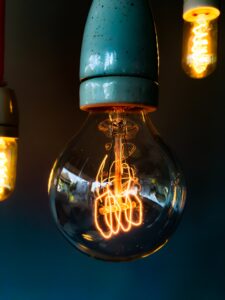How to Reduce Energy Waste in Your Home
 Do you want to save money and help the planet at the same time? Reducing energy waste in your home can accomplish both goals. Everyone can benefit from addressing common leaks and saving their hard-earned money. Here’s your 12-step guide to reducing energy waste in your home.
Do you want to save money and help the planet at the same time? Reducing energy waste in your home can accomplish both goals. Everyone can benefit from addressing common leaks and saving their hard-earned money. Here’s your 12-step guide to reducing energy waste in your home.
Start at the Top
You lose approximately 25% of your home’s energy through your roof. It leaks out in two sneaky ways.
1. Chimney
When was the last time you inspected your damper? Many people forget to close them after a fire, sending heat right out the chimney. Check your switch. Others have worn devices that don’t close all the way. If you feel a breeze when you stick your head in the fireplace, it’s time for a replacement.
2. Heat Loss Through the Roof
Air can escape through the roof itself, from egress areas as well as leaks and missing tiles. If the damage remains within a concentrated area, you might get away with a repair. Some people avoid a full replacement by re-roofing, but this fix is only temporary as existing problems remain. Eventually, you’ll need a replacement.
Additionally, there is a possibility you could be eligible for government incentives, like a reimbursement by the Department of Energy for making sustainable roofing renovations. From prepping your roof for solar panels to roofing insulation, there are a variety of options to reduce energy leakage and get refunded.
Move to the Perimeter
Your home loses the most heat from the middle. Here’s how to shore up those areas and lower your utility bills.
3. Walls
Fortunately, you don’t have to be a trim carpenter or rip down your drywall to add insulation. You can drill a small hole at the top to blow in confetti-like stuff to plug the gaps. However, you must remain aware of horizontal studs that protect outlets but could leave a gap of uninsulated space below. You might consider a professional contractor if you aren’t too handy with a finder.
4. Windows
Here’s a project that’s easy to DIY with the right knack. Invest in a high-quality caulking gun and practice drawing a bead on cardboard before moving to your windows. Seal all the cracks — if you still catch a chill, it may be time for replacements.
5. Doors
Doors are another easy fix — just add weather stripping. It’s easy to apply by peeling off the backing and adhering it to the frame.
You might look beneath the door, too. If your door is slightly short, you’ll see a gap. Fortunately, a simple breeze guard solves the problem, which you can install without any tools.
6. Garage
An uninsulated garage is a huge energy waster that many overlook. Every time you open the interior door, it’s like stepping outside. How many of us prop it open to carry in groceries or load the kiddos in the car for soccer practice?
Insulate your garage for extra protection. As a bonus, any rooms above the space will no longer have freezing floors in the winter.
The Cost of Comfort
Your home heating and air conditioning use the most energy in your home. Improving the efficiency of these systems can reduce overall waste.
7. Poorly Maintained HVAC
When did you last change your filter? This simple task improves efficiency tremendously. If you’ve gone so long that you see a grayish discoloration around your vents, take these steps:
- Turn off the HVAC.
- Remove the filter grate and vent covers. Wash them with hot, soapy water.
- Remove the filter.
- Vacuum inside the tubes. Use your vacuum hose, taking care not to scrape the sides.
- Replace the filter with a fresh model.
- Restart your system.
8. AC in the Sun
Keeping your condenser cooler will improve your air conditioner’s efficiency. If possible, place it on the north side of your home or use shading to keep it out of the worst of the midday heat. However, it may be difficult to do if your unit is mounted on your roof.
9. Landscaping
One way to shade your condenser is with a trellis covered in climbing vines. Placing trees that shade your home’s south side will keep it cooler in summer. Taking down obstructions around the northern half will keep it warmer in winter.
Watch Out for Interior Vampires
Even homes with secure perimeters and solid temperature control can waste energy. Here are some interior vampires you should know about and address.
10. Plugged-In Appliances
Even when you power devices down, they continue to draw phantom electricity. While no one suggests that you move your stove and unplug it nightly, pull the plug on small appliances. Use power strips on collections of gadgets like entertainment centers to extinguish them all at once.
11. Old Hot Water Heater
Your water heater draws considerable energy. When was the last time you drained it? Sediment buildup can decrease efficiency. If all that silt has become immovable and it’s time for a replacement, consider a tankless model with a high Energy Star rating.
12. Inefficient Light Bulbs
LED replacement bulbs might cost more initially, but they last up to 25 times longer while using 75% less energy. The result? You save money in the long run while keeping your home bright and cheery. You can even experiment with various tones, using cooler amber hues to induce a sense of relaxation.
How to Reduce Energy Waste in Your Home
Reducing energy waste in your home isn’t only a gift to mother earth. It’s also how to keep more green in your wallet. Leaving these vampires unaddressed is like throwing your money out the window. Use the 12-step guide above to reduce energy waste in your home.


